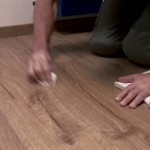Do You Have To Install Padding Under Laminate Flooring?
Laminate flooring, a popular choice for both residential and commercial spaces, offers durability, aesthetic appeal, and relative ease of installation. However, a common query among those considering laminate flooring is whether an underlayment, often referred to as padding, is a necessary component. The answer, in short, is generally yes. While specific situations may warrant exceptions, understanding the multifaceted benefits of underlayment clarifies why it is typically considered essential for a successful and long-lasting laminate floor.
The purpose of this article is to explore the various reasons why underlayment is typically recommended for laminate flooring installations. It will delve into the advantages it provides, the potential drawbacks of omitting it, and the specific scenarios where the necessity of underlayment might be debated. This comprehensive overview will provide a clear understanding of the role of underlayment in ensuring the optimal performance and longevity of a laminate floor.
The Multifaceted Benefits of Underlayment
Underlayment serves several crucial functions that contribute to the overall performance and lifespan of a laminate floor. These benefits extend beyond mere comfort and include sound reduction, moisture protection, and support for the locking mechanisms of the laminate planks.
One of the primary benefits of underlayment is sound reduction. Laminate flooring, by its nature, can be somewhat noisy underfoot. Without an underlayment to absorb impact and dampen vibrations, footsteps and other movements can generate significant noise that transmits through the floor and into the surrounding spaces. Underlayment acts as a sound barrier, minimizing the transmission of sound and creating a quieter, more comfortable living environment. This is especially important in multi-story buildings or areas where noise control is a priority.
Moisture protection is another critical function of underlayment. Concrete subfloors, in particular, are prone to moisture vapor emission. This moisture can wick up through the subfloor and damage the laminate flooring from below, causing warping, swelling, and mold growth. Many underlayments incorporate a moisture barrier that blocks moisture vapor and prevents it from reaching the laminate planks. This protective layer is vital for maintaining the integrity and longevity of the flooring, particularly in basements or other areas with high humidity.
Furthermore, underlayment provides a level of cushioning and support for the laminate planks. It helps to even out minor imperfections in the subfloor, preventing the planks from flexing or bending under weight. This support reduces stress on the interlocking edges of the laminate planks, preventing them from separating or breaking over time. By providing a stable and even surface, underlayment extends the lifespan of the flooring and prevents premature wear and tear. The added cushioning also contributes to a more comfortable feel underfoot, reducing fatigue and improving the overall walking experience.
Improved thermal insulation is another benefit, albeit often less emphasized. Underlayment can provide a degree of thermal resistance, helping to insulate the floor and reduce heat loss. This can contribute to lower energy bills and a more comfortable indoor environment, particularly in colder climates.
Finally, using the correct underlayment can sometimes be a requirement for maintaining the manufacturer's warranty on the laminate flooring. Many manufacturers specify the type and thickness of underlayment that must be used to validate the warranty. Failing to meet these requirements could void the warranty, leaving the homeowner responsible for any repairs or replacements necessitated by improper installation.
Potential Drawbacks of Omitting Underlayment
While the benefits of underlayment are numerous, neglecting to install it can lead to a range of problems that compromise the performance and longevity of the laminate floor. These issues can range from increased noise levels to significant structural damage, ultimately resulting in costly repairs or replacements.
Increased noise transmission is one of the most immediate and noticeable consequences of omitting underlayment. Without a sound-absorbing layer, footsteps and other movements will generate significantly more noise, creating a less comfortable and potentially disruptive living environment. This is particularly problematic in apartments or condos where noise can easily transmit to neighboring units.
Damage from moisture is another significant risk. If the subfloor is not properly sealed and protected from moisture, it can seep into the laminate planks and cause them to warp, swell, or buckle. This damage can compromise the structural integrity of the floor and create unsightly surface imperfections. Mold growth is another potential consequence of moisture exposure, which can pose a health hazard and require professional remediation.
Another potential problem is unevenness and instability. Without underlayment to cushion and support the laminate planks, they may be more susceptible to flexing or bending under weight. This can lead to premature wear and tear on the interlocking edges, causing them to separate or break over time. The result is a floor that feels uneven and unstable underfoot, and which is more prone to damage from everyday use.
Warranty invalidation is a crucial consideration. As mentioned earlier, many laminate flooring manufacturers require the use of approved underlayment to validate the warranty. Installing the flooring without underlayment, or using an unapproved type of underlayment, could void the warranty, leaving the homeowner responsible for any repairs or replacements required due to installation-related issues.
Reduced comfort is an often overlooked drawback. The absence of underlayment can make the floor feel harder and less comfortable to walk on. This can be particularly noticeable in areas where people spend a lot of time standing or walking, such as kitchens or hallways. The lack of cushioning can also contribute to fatigue and discomfort, especially for individuals with joint problems or other mobility issues.
Situations Where Underlayment Might Be Debated
Although underlayment is generally recommended for laminate flooring installations, there are a few specific scenarios where its necessity might be questioned or debated. These situations typically involve laminate flooring with pre-attached underlayment or installations over certain types of subfloors.
Some laminate flooring products come with a pre-attached underlayment on the underside of each plank. This built-in padding provides some of the benefits of a separate underlayment, such as sound reduction and cushioning. In these cases, a second layer of underlayment might seem redundant. However, it is crucial to consider the quality and thickness of the pre-attached underlayment. If it is thin or of low quality, it may not provide sufficient sound insulation or moisture protection, and an additional layer of underlayment may still be beneficial. Furthermore, some manufacturers may still require a specific type of underlayment to be used in conjunction with the pre-attached padding to validate the warranty.
Another situation where the necessity of underlayment might be debated is when installing laminate flooring over certain types of subfloors, such as perfectly level and smooth plywood or OSB. In these cases, the primary function of the underlayment would be to provide sound insulation and moisture protection. If the subfloor is already adequately sealed and protected from moisture, and if noise is not a concern, then the need for underlayment may be less critical. However, it is still generally advisable to install underlayment to provide additional cushioning and support, as well as to protect the laminate planks from minor imperfections in the subfloor.
Floating floors installed over radiant heating systems present a unique situation. In these cases, the underlayment must be specifically designed to allow heat to transfer efficiently through the floor. Standard underlayments can impede heat transfer, reducing the efficiency of the heating system and potentially causing damage. Therefore, it is essential to use an underlayment that is specifically approved for use with radiant heating systems. In some situations, the radiant heating system itself may provide sufficient insulation and cushioning, in which case a separate underlayment may not be necessary. However, it is crucial to consult with the radiant heating system manufacturer to determine the appropriate underlayment requirements.
Ultimately, the decision of whether or not to install underlayment under laminate flooring should be based on a careful assessment of the specific circumstances, including the type of laminate flooring, the condition of the subfloor, the desired level of sound insulation, and the presence of any moisture concerns. Consulting with a flooring professional can help to determine the best course of action and ensure a successful and long-lasting installation. Ignoring professional advice can turn into a regretful and expensive lesson.

The Difference Between Underlayment And Underpads

Why You Should Put Underlayment Under Your Laminate Floor Swisskrono Com

Types Of Laminate Flooring Underlay Which To Choose

Underlayment Buyer S Guide

When Underlayment Is Not Necessary For Laminate Flooring Mp Global S Llc

Can You Use Carpet Padding Under Laminate Flooring Upgradedhome Com

The Advantages Of Poly Foam Underlay Blog Floorsave

Underlayment For Vinyl Flooring Best Options Home Pros

Do You Need An Underlayment For Vinyl Plank Flooring

Can I Install Laminate Flooring Over Carpet Underlayment
Related Posts








